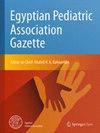Factor analysis of hepcidin on cardiac iron overload and fibrosis among thalassemia major children
IF 0.5
Q4 PEDIATRICS
引用次数: 0
Abstract
Cardiac iron overload is a common cause of death in thalassemia major and is associated with hepcidin, which is primary iron homeostasis. Therapeutics that could increase hepcidin levels or act as hepcidin agonists might help treat the abnormal iron absorption in individuals with β-thalassemia and related disorders. We aimed to verify the structure and study the relationship of release variables, hepcidin, cardiac iron overload, or fibrosis. A cross-sectional study was conducted among thalassemia majors, aged 6–18 years at Rumah Sakit Anak dan Bunda Harapan Kita Indonesia, between January 2019 and May 2020. Clinical data, hepcidin-25, interacting variables laboratory test, MRIT2* used to assess cardiac iron overload, late gadolinium enhancement (LGE), and soluble suppression of tumoregenicity2 (ST2) to assess fibrosis were studied. The correlation test was performed with SPSS version 20, Amos 22 was used to assess confirmatory factor analysis (CFA), and squared multiple correlation (SMC) was used to determine the proportion of total variation explained by the model. We recruited 80 patients, of those 8 (10%) were cardiac iron overload, 5 (5.25%) were fibrosis, and 3 (3,75%) were ST2 > 35 mg/dL. CFA showed variables that interact with hepcidin release were Hb, reticulocyte-He (Re-He), HIF-1α, Immature granulocyte (IG), hs-CRP, IL-6, ferritin, and transferrin saturation. There was no direct hepcidin role in cardiac iron overload and fibrosis. No interacting variable role on hepcidin. SMC of hepcidin on cardiac iron overload was 20%. Factor analysis of hepcidin was Hb, Ret-He, HIF-1α, IG, hs-CRP, IL-6, ferritin, and transferrin saturation. No direct hepcidin role in cardiac iron overload and fibrosis. Hepcidin explains approximately 20% of the total variation in cardiac iron overload.地中海贫血患儿血红蛋白对心脏铁负荷过重和纤维化的影响因素分析
心脏铁负荷过重是重型地中海贫血症患者的常见死因,这与血红素有关,而血红素是铁平衡的主要物质。能提高血红素水平或作为血红素激动剂的治疗药物可能有助于治疗β地中海贫血及相关疾病患者的铁吸收异常。我们的目的是验证释放变量、血钙素、心脏铁负荷过重或纤维化的结构并研究它们之间的关系。我们于2019年1月至2020年5月期间在印度尼西亚Rumah Sakit Anak dan Bunda Harapan Kita对6-18岁的地中海贫血患者进行了横断面研究。研究对象包括临床数据、肝素-25、交互变量实验室测试、用于评估心脏铁超载的MRIT2*、晚期钆增强(LGE)和用于评估纤维化的可溶性抑制肿瘤基因2(ST2)。用 SPSS 20 版进行相关性检验,用 Amos 22 评估确证因子分析(CFA),用平方多重相关性(SMC)确定模型解释的总变异比例。我们招募了 80 名患者,其中 8 人(10%)为心脏铁负荷过重,5 人(5.25%)为纤维化,3 人(3.75%)ST2 > 35 mg/dL。CFA显示,与肝素释放相关的变量包括血红蛋白、网状细胞-He(Re-He)、HIF-1α、未成熟粒细胞(IG)、hs-CRP、IL-6、铁蛋白和转铁蛋白饱和度。血红素在心脏铁负荷过重和纤维化中没有直接作用。肝磷脂没有相互作用的变量。血钙素对心脏铁负荷过重的SMC为20%。血红蛋白的因子分析包括血红蛋白、Ret-He、HIF-1α、IG、hs-CRP、IL-6、铁蛋白和转铁蛋白饱和度。肝素在心脏铁负荷过重和纤维化中没有直接作用。肝素可解释心脏铁负荷过重总变化的约 20%。
本文章由计算机程序翻译,如有差异,请以英文原文为准。
求助全文
约1分钟内获得全文
求助全文
来源期刊

Egyptian Pediatric Association Gazette
PEDIATRICS-
自引率
0.00%
发文量
32
审稿时长
9 weeks
期刊介绍:
The Gazette is the official journal of the Egyptian Pediatric Association. The main purpose of the Gazette is to provide a place for the publication of high-quality papers documenting recent advances and new developments in both pediatrics and pediatric surgery in clinical and experimental settings. An equally important purpose of the Gazette is to publish local and regional issues related to children and child care. The Gazette welcomes original papers, review articles, case reports and short communications as well as short technical reports. Papers submitted to the Gazette are peer-reviewed by a large review board. The Gazette also offers CME quizzes, credits for which can be claimed from either the EPA website or the EPA headquarters. Fields of interest: all aspects of pediatrics, pediatric surgery, child health and child care. The Gazette complies with the Uniform Requirements for Manuscripts submitted to biomedical journals as recommended by the International Committee of Medical Journal Editors (ICMJE).
 求助内容:
求助内容: 应助结果提醒方式:
应助结果提醒方式:


